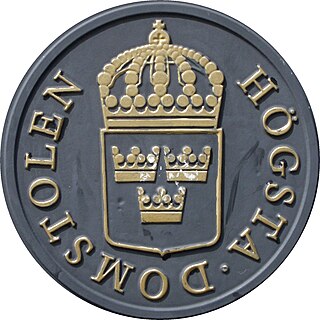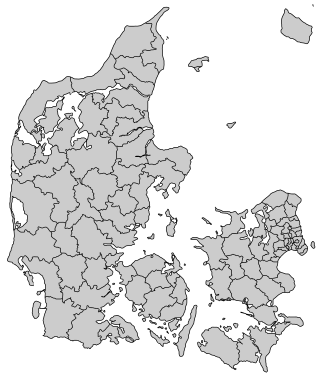
Gotland County is a county or län of Sweden. Gotland is located in the Baltic Sea to the east of Öland, and is the largest of Sweden's islands. Counties are usually sub-divided into municipalities, but Gotland County consists of only one county council, which also serves as a municipality, Region Gotland. Gotland County is the only county in Sweden that is not governed by a municipal council. The municipality handles the tasks that are otherwise handled by the county council: mainly health care and public transport. Like other counties, Gotland has a County Administrative Board, which oversees implementation of the Swedish state government. Both the County Administrative Board and the municipality have their seat in the largest city, Visby, with over 22,000 inhabitants. Princess Leonore, the daughter of Princess Madeleine, is Duchess of Gotland.
A county is a geographic region of a country used for administrative or other purposes in some nations. The term is derived from the Old French comté denoting a jurisdiction under the sovereignty of a count (earl) or, in his stead, a viscount (vicomte). Literal equivalents in other languages, derived from the equivalent of "count", are now seldom used officially, including comté, contea, contado, comtat, condado, Grafschaft, graafschap, and zhupa in Slavic languages; terms equivalent to 'commune' or 'community' are now often instead used.

Local government is a generic term for the lowest tiers of governance or public administration within a particular sovereign state.

The politics of Sweden take place in a framework of a parliamentary representative democratic constitutional monarchy. Executive power is exercised by the government, led by the Prime Minister. Legislative power is vested in both the government and parliament, elected within a multi-party system. The judiciary is independent, appointed by the government and employed until retirement. Sweden is formally a monarchy with a monarch holding symbolic power.

Skåne County, sometimes referred to as Scania County in English, is the southernmost county, or län, of Sweden, mostly corresponding to the traditional province of Scania. It borders the counties of Halland, Kronoberg and Blekinge and connects to Capital Region, Denmark by the Öresund Bridge across the Øresund strait. The seat of residence for the Skåne Governor is the city of Malmö. The headquarters of Skåne Regional Council are located in both Kristianstad and Malmö.

Västra Götaland County is a county or län on the western coast of Sweden.

Dalarna County is a county or län in central Sweden (Svealand). It borders on the counties of Uppsala, Jämtland, Gävleborg, Västmanland, Örebro and Värmland. It also borders on the Norwegian counties of Hedmark and Trøndelag to the west. It was formerly known as Kopparberg County until the name was changed to that of the provincial region on 1 January 1997. The province of Dalarna is slightly larger than the county, as the westernmost part of Ljusdal Municipality belongs to it. Prince Gabriel, the son of Prince Carl Philip, is Duke of Dalarna.

Jönköping County is a county or län in southern Sweden. It borders the counties of Halland, Västra Götaland, Östergötland, Kalmar and Kronoberg. The total county population was 356,291 inhabitants in September 2017. The capital and largest city is Jönköping. About one quarter of the total county population lives in the combined Jönköping-Huskvarna urban area around the southern point of Lake Vättern.

The counties of Sweden are the administrative subdivisions of Sweden. They are not regarded as geographical areas by Swedes as they are not connected to dialects or identity, which is a role fulfilled by the historical provinces of Sweden. Sweden is today divided into 21 counties; however, the number of counties has varied over time, due to territorial gains/losses and to divisions and/or mergers of existing counties. This level of administrative unit was first established in the 1634 Instrument of Government on Lord Chancellor Count Axel Oxenstierna's initiative, and superseded the landskap, in order to introduce a more efficient administration of the realm. At that time, they were what the translation of län into English literally means: fiefdoms. The county borders often follow the provincial borders, but the Crown often chose to make slight relocations to suit its purposes.
A region is a self-governing local authority of Sweden. There are 21 regions, each corresponding roughly to a county. Regions are governed by a regional assembly (regionfullmäktige) that is elected every four years in conjunction with the general elections. The most important responsibilities of regions are the public health care system and public transportation. It is one of the principal administrative subdivisions of Sweden.

The municipalities of Sweden are its lower-level local government entities. There are 290 municipalities which are responsible for a large proportion of local services, including schools, emergency services and physical planning.

The Supreme Court of Sweden is the supreme court and the third and final instance in all civil and criminal cases in the Kingdom of Sweden. Before a case can be decided by the Supreme Court, leave to appeal must be obtained, and with few exceptions, leave to appeal can be granted only when the case is of interest as a precedent. The Supreme Court consists of 16 Justices who are appointed by the government, but the court as an institution is independent of the Riksdag, and the Government is not able to interfere with the decisions of the court.
The administrative divisions of the Nordic countries are similar given the countries' shared culture and history.
This article shows the administrative divisions of Iceland.

The judicial system of Sweden consists of the law of Sweden and a number of government agencies tasked with upholding security and rule of law within the country. The activities of these agencies include police and law enforcement, prosecution, courts, and prisons and other correctional services.

The Supreme Administrative Court of Sweden is the supreme court and the third and final tier for administrative court cases in Sweden, and is located in Stockholm. It has a parallel status to that of the Supreme Court of Sweden, which is the supreme court for criminal and civil law cases.
Norway's elongated shape, its numerous internal geographical barriers and the often widely dispersed and separated settlements are all factors that have strongly influenced the structure of the country's administrative subdivisions. This structure has varied over time and is subject to continuous review. In 2017, the government decided to abolish some of the counties and to merge them with other counties to form larger ones, reducing the number of counties from 19 to 11, which was implemented on 1 January 2020. Following protests, the new government decided to abolish three of the new counties in 2022, and re-establish seven of the old ones. Taking effect on 1 January 2024 there are fifteen counties in Norway.

Denmark is divided into five regions, which contain 98 municipalities. The Capital Region has 29 municipalities, Southern Denmark 22, Central Denmark 19, Zealand 17 and North Denmark 11. The government intends to merge R. Hovedstaden with R. Sjælland 1 January 2027 to form Region Østdanmark. The regional council will have 41 members, and will be elected Tuesday 18 November 2025 in the ordinary 2025 Danish local elections.

The administrative courts of appeal in Sweden is the second tier for the general administrative courts in Sweden. The next and final instance is the Supreme Administrative Court. There are four administrative courts of appeal, and they mostly handle cases and other judicial issues that have already been dealt with by the lower courts. In addition to this, they also act as court of first instance in cases related to the principle of public access to official records.










